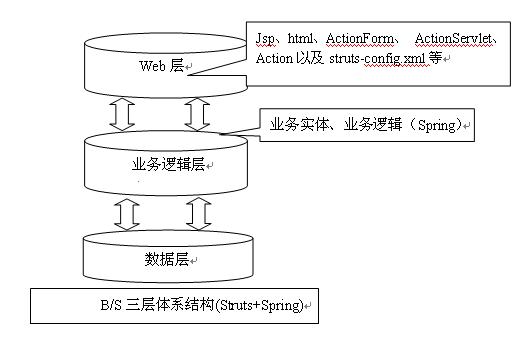Spring與Struts集成開發
最近喜歡將所學的東西理順一下,且發現寫blog可以達成這目的。
那就來整理一下我對Spring與Struts集成開發的一些想法。
首先確認系統的結構為三層的B/S模式結構,如下圖:

在圖中看出,Spring和Struts集成開發中,Spring在業務邏輯層被使用(集成)。因為Spring框架的依賴注入,AOP及可聲明的事務管理方面的技術優勢,使得用Spring來管理業務實體,實體之間的依賴關系,業務邏輯服務接口變得簡單且可配置。至此我們要清楚:Spring和Struts集成開發中,Spring在業務邏輯層被使用(集成)。
清楚Struts和Spring在系統結構中分別充當的角色后,接下來要討論:如何實現集成?
1、使用Spring的ActionSurpert類集成Struts。
org.springframework.web.struts.ActionSurpert是一個繼承org.apache.struts.action.Action的類,簡要代碼如下:
public abstract class ActionSurpert extends Action {
private WebApplicationContext webApplicationContext;
public void setServlet(ActionServlet actionServlet) {//當容器實例化此Action時被容器調用
surper.setServlet(actionServlet);
if(actionServlet != null) {
this.webApplicationContext = initWebApplicationContext(actionServlet);//獲取webApplicationContext
//........
}else{
//.......
}
}
//通過getXXX()方法獲取 webApplicationContext 對象
protected final WebApplictionContext getWebApplicationContext() {
return this.webApplicationContext;
}
}
通過上述代碼可以看出,所有繼承了ActionSupport類的Action將可以通過WebApplicationContext對象的getBean(beanKey)方法獲得Spring配置文件中定義的各種Bean。
WebApplicationContext要由Web Server來加載,有兩種方法:
1、通過org.springframework.web.struts.ContextLoaderPlugIn加載,ContextLoaderPlugIn是個插件,需要在Struts配置文件中配置。
<plug-in className="org.springframework.web.struts.ContextLoaderPlugIn">
<set-property property = "contextConfigLocation" value="/WEB-INF/applicationContext.xml"></set-property>
</plug-in>
2、在web.xml文件中加載
<context-param>
<param-name>contextConfigLocation</param-name>
<param-value>/WEB-INF/applicationContext.xml</param-value>
</context-param>
<servlet>
<servlet-name>context</servlet-name>
<servlet-class>org.springframework.web.context.ContextLoaderServlet</servlet-name>
<load-on-startup>1</load-on-startup>
</servlet>
舉個簡單的例子說明一下相關配置信息:
假定有ExampleAction,ExampleBean,ExampleService這幾個類,它們工作流程是:
用戶請求ExampleAction,ExampleAction調用ExampleService的接口方法對ExampleBean進行相關的操作。
1、applicationContext.xml中配置相關的bean信息
<beans>
<bean id="dataSource" class="org.springframework.jdbc.datasource.DriverManagerDataSource">
<property name="driverClassName">
<value>com.mysql.jdbc.Driver</value>
</property>
<property name="url">
<value>jdbc:mysql://localhost:3306/ssh?useUnicode=true&characterEncoding=UTF-8</value>
</property>
<property name="username">
<value>root</value>
</property>
<property name="password">
<value>root</value>
</property>
</bean>
<bean id="exampleBean" class="org.mypackge.beans.ExampleBean"/>
<bean id="exampleBeanService" class="org.mypackge.services.ExampleService"/>@
</beans>
通過這樣配置后,在ExampleAction中可以用getWebApplicationContext() 獲得webApplicationContext對象,然后通過
webApplicationContext的getBean(beanKey)方法獲得相應的bean進行業務處理。標了紅色的"beanKey"就是applicationContext.xml中<bean>元素定義的bean id,如:webApplicationContext.getBean("exampleBeanService")。@
當然,ExampleAction還要在stuts-config.xml配置文件中配置,這里不作介紹。
2、使用Spring的Action代理集成Struts
這種集成方式的核心思想是,將Struts的配置文件中的所有Action的type屬性設為org.springframwork.web.struts.DelegationActionProxy。當用戶請求Action時,就執行這代理,代理會在Spring應用上下文中找到真正的Action,然后交給它處理用戶的請求。而真正用于處理用戶請求的Action的配置放在了Spring的配置文件中。這樣,Struts中的Action以及其依賴關系就可以用Spring容器來管理,比如將業務邏輯對象注入到Action中,供其使用。簡單片段<bean name="/exampleAction" class="org.myproj.struts.actions.ExampleAction">
....
</bean>
說明:用name屬性而不是用id來標識這個Bean,Spring不允許ID中出現"/",而name可以;"name"屬性值要和struts-config.xml文件中相應<action>元素中的path屬性值相同(<action path="/exampleAction"),這樣Action代理才能找到相應的Action來處理請求。
歡迎討論,提出寶貴意見。
posted on 2008-03-01 11:08
Sonny Li 閱讀(830)
評論(2) 編輯 收藏 所屬分類:
框架相關